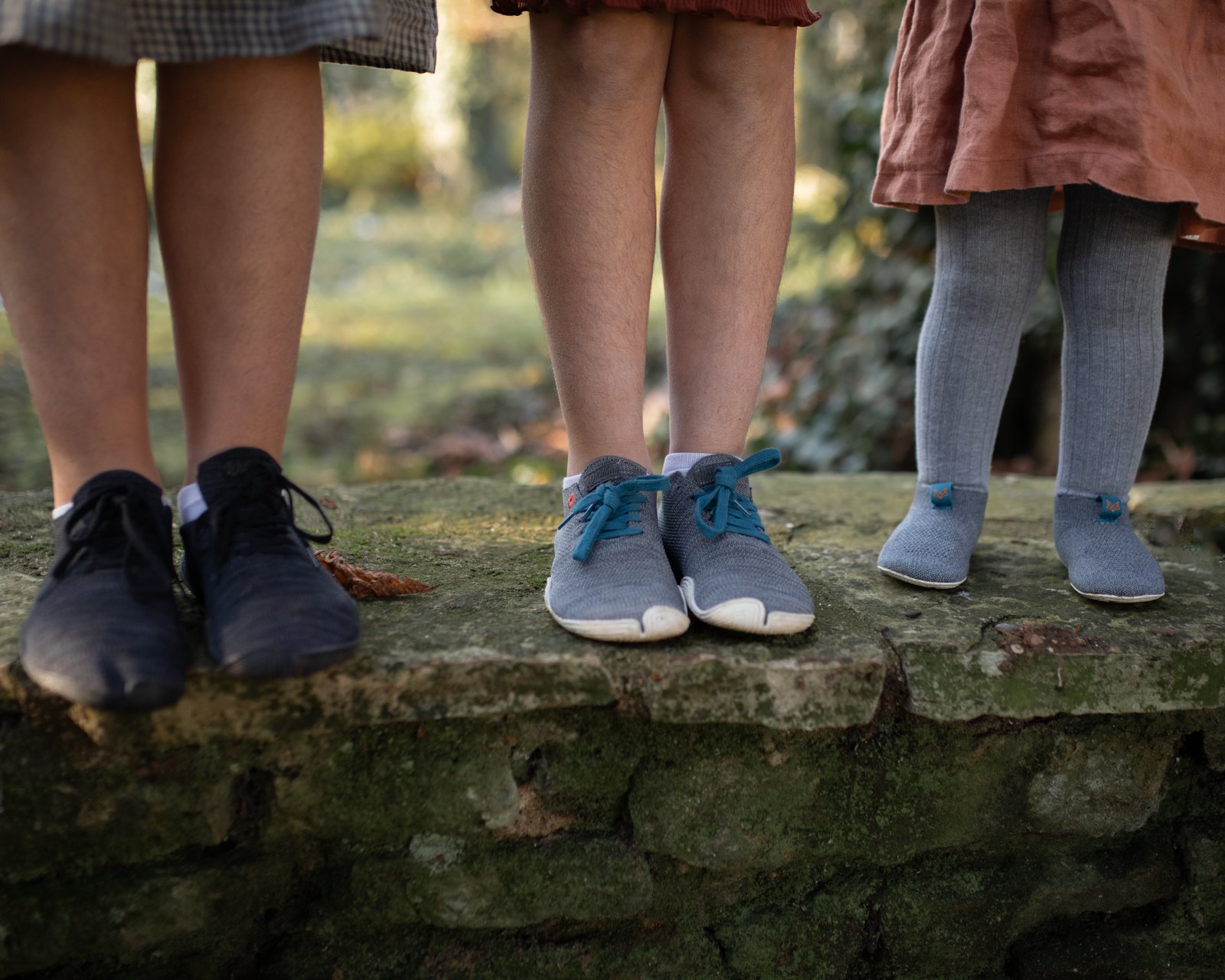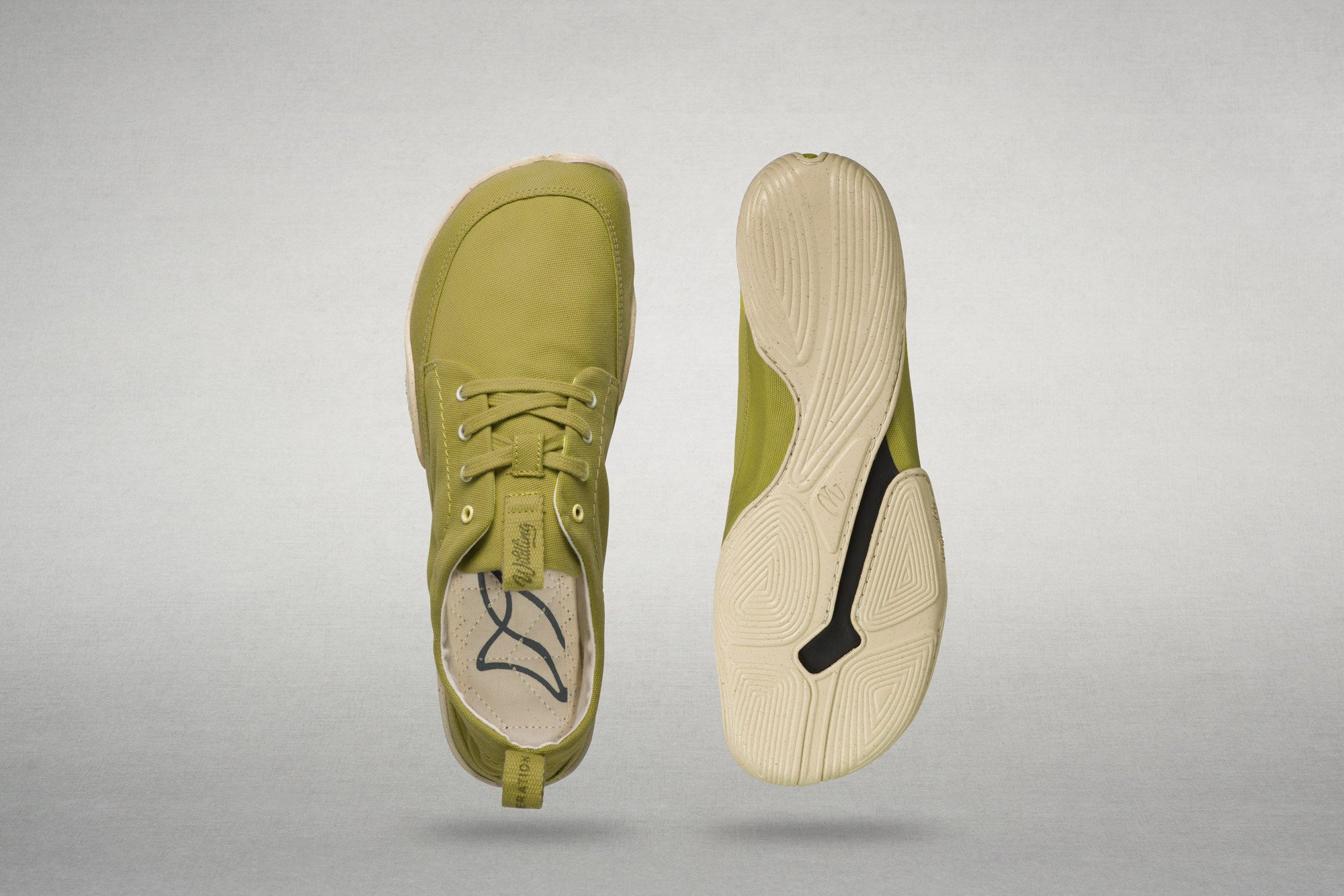A Shoeless Childhood is a Happy (Healthy) Childhood
Ran Yona, a sports therapist, founded Wildling Shoes together with his wife Anna. Six years ago, they stumbled (so to speak) upon an adventure that unveils, little by little, the beauty and power children’s feet encompass.
The first time our children needed shoes on a daily basis was when the German winter showed up on our doorstep. In the spring of 2013, we moved to Germany, after living in Israel for 12 years, where our kids went barefoot for most of their lives. Even in winter. But here, with freezing temperatures, winter was a different story. So we had to get them shoes.
Sturdy winter boots walking in the snow
The change in the way they moved was immediate – from what had been an agile, confident way of walking and moving, we began to see a bit of hesitation creeping into their gait. Our son, whom we nicknamed “Cat”, started stumbling. It was painful to watch. Shoes off, back to fluent movement and cat-like balance; shoes on, and their confidence was shaken.
So of course we felt we had to do something about it and the race was on. While researching, we had the chance to talk to many parents and everyone said the same thing: “My kid hates wearing shoes!”; Clearly, the problem was bigger than we first thought, so the solution (as we saw it), had to be just as drastic. Kids’ shoes needed a thorough makeover.
Wildling Shoes was born from this passion.
Six years have passed since embarking on this endeavor, and despite the fact that we are proud of our product, there is still one better way to go. This is what we’ve learned about the importance of letting kids walk barefoot as much as possible:
1. It affects how they run
Running is probably one of the first things kids learn how to do, and they master the skill from a very early stage with an innate ability to cover quite a distance. But do conventional shoes really help them run, or do the biomechanical changes they cause actually discourage our kids from doing so? (1, 2, 3)
Runner using conventional heeled running shoes on the street
Do the biomechanics of their body as a whole change when we add artificial extras to their limbs? Taking longer (and higher) running steps, with a heavy landing pattern on the heels, is only made possible by the thickness of a cushioned shoe.
Running is basically akin to jumping rope from one leg to the other while moving forward. So in the same way no one jumps rope on their heels, and considering evolution, science, and the way most kids (and adults) run without shoes, it becomes painfully clear how the extra cushioning and weight on their legs can distort their body’s inherent way of running, transforming it into a more artificial movement that’s less efficient and more tiring.
Or, as this study sums it up (4): “A possible explanation for improved running speed may be due to modified foot mechanics during the landing phase. Thus, instead of landing on the heel as is usual in training shoes during a running stride, the participants improved running pace by contacting the track with the ball of the foot, activating the calf and foot muscles”.
Furthermore, the findings of this study were similar to those reported in the literature, where running performance in training shoes was worse than when barefoot. One possible reason may be due to the energy cost associated with shod running. Oxygen consumption at 12 km/h is 4.7% higher when wearing training shoes weighing 700 g [6].
Girl running barefoot outside on wet concrete
Training footwear is also believed to compromise the ability of the lower limb to act like a spring. With bare feet, the limb returns ~70% of stored energy stored, but with shoes, the return was found to be considerably less.
2. It affects the size and development of their foot bones and muscles
When astronauts return from space, they undergo a bone density checkup to see if they’ve lost any bone mass. With no gravity, they have to take preventive measures (resistance training) to avoid suffering from osteoporosis (bone tissue loss).
The principle behind this is called Wolff’s Law, which states that “bones will adapt, based on the amount and direction of stress applied to them.” This is especially true for younger children whose bones are constantly developing and being reshaped. It is painfully true when it comes to our feet.
Anatomical foot model
The size, strength, and direction of the bones in a growing foot is dependent, apart from the impact of nutrition, on the kind of stress put on them. The shape that our kids’ feet will take after their adolescent years will be the base that carries them for the rest of their lives. And like most growing, living things, feet need the struggle to reach their full potential, ideally in an open environment, where they can put each and every talent they possess to good use.
This healthy development can’t completely unfold when feet are restricted in an inflexible shoe from such a young age, tapered into a narrow toe box that doesn’t allow foot muscles to achieve their full range of motion, which leads to their thwarted and incomplete development. Hence, the bones they’re attached to will also only develop to that limited extent.
The heel bone (calcaneus) is vulnerable in a very practical way, as it serves as the anchor to both the intrinsic (inner) muscles and ligaments of the foot from its front side as well as to the Achilles tendon, which bundles together two of the strongest movers of the foot, from its back side. So when the inner muscles inside the shoe can’t function normally because of arch support and a stiff sole coupled with a heel elevation that restricts the range of motion of the Achilles tendon, the heel bone won’t be able to reach its fully developed anatomical shape.
On top of that, the pitching of the toes in a conventional shoe changes the natural alignment of the toes and arches of the foot, shifting the forces applied to them sideways during walking and running, and thus opening the door to flat feet (pes planus) and other foot deformities (5, 9).
3. It can strengthen their concentration and peripheral vision, and provide a better sense of body-eye coordination (7)
Going barefoot forces our conscious mind to be more focused and alert in order to prevent us from stubbing our toes, or worse − stepping on something nasty. Staying sharp is imperative. This aspect of barefoot walking can bring children into an almost meditative state, helping them develop a better sense of awareness and mindfulness.
A barefoot child balancing on a large rock in a stream
4. Less cushion provides a better buffer − it can protect their joints (10, 11)
In his latest study about calluses, Professor Lieberman notes a very important finding (6):“With cushioned shoes, the stiffness of the sole slows the rate at which the body hits the ground, making the impact more comfortable, but the force is the same. The energy that gets shot up your leg is about three times greater in a cushioned shoe than if you’re barefoot”... We have no idea what that means for joint health. It is theoretically possible that this extra impact is behind the doubling rates of arthritis of the knee since World War II.
Three children playing barefoot on the asphalt
Degenerative diseases develop over time and manifest themselves only after years or decades of misuse. Like drops of water hitting a rock. By letting our kids go barefoot as much as possible, we allow them to adapt their individual way of movement, which is more enjoyable for them and also more effective in attenuating a bigger portion of the ground force impact exerted on them. In doing so, we’re not only minimizing the damage to their bones and joints, we’re actually helping them build greater bone mass reserves for years to come (12).
5. It improves overall athletic ability and motor development (8)
A recent study conducted by Professor Astrid Zech from the University of Jena and Professor Ranel Venter from Stellenbosch University compared 810 kids and adolescents from Germany (shod most of the time) and South Africa (barefoot most of the time) and assessed three motor skills — balance, standing long jump, and a 20 m sprint.
The results were unambiguous:
“Our finding, that these children (unshod) performed better in balancing and jumping, supports the hypothesis that the development of basic motor skills during childhood and adolescence at least partly depends on regular barefoot activities.”
6. It can strengthen their connection with nature
The reaction of a child sticking her feet into mud is priceless! A one-of-a-kind expression of amazement, fear, surprise, joy, curiosity, and a smile that lights up their entire face! We connect to our surroundings through our feet. They are packed with feelers. So that appreciation for mother nature, her importance, becomes closer to our kid’s hearts when their feet are allowed to transmit the beauty and different textures she has to offer.
Young child playing barefoot outside on gravel
Once kids notice more, they become more observant, and suddenly there is a beetle, or a special leaf, an ant’s nest and yes, also dying forests, drying rivers, and more yellow meadows and public parks. Reconnecting with their environment and seeing how vital it is to their own habitat and how that, in turn, is connected to the grand plan of where we all go, is a valuable and essential story.
Our feet can help convey this vital story − we only need to give them the chance to tell it.
7. And if there’s one good reason for kids to take their shoes off, it’s simply because they seem to have a lot more fun without them!
Very rarely do we hear a kid saying, “I want my shoes back on”; and that by itself says a lot!
Three young girls play barefoot in the sandbox
1. https://link.springer.com/article/10.1186/1757-1146-4-3
2. https://www.sciencedirect.com/science/article/abs/pii/S0966636217308329
3. https://www.tandfonline.com/doi/abs/10.1080/17461391.2017.1422545
4. https://pdfs.semanticscholar.org/4085/c2b29dae6853096dd34fa8596ff4fccebf44.pdf
5. https://www.sciencedirect.com/science/article/abs/pii/S0958259206000770
6. https://www.scientificamerican.com/article/going-barefoot-is-good-for-the-sole/
7. https://journals.sagepub.com/doi/abs/10.1177/0031512519863183
9. https://online.boneandjoint.org.uk/doi/abs/10.1302/0301-620x.74b4.1624509
10. https://pubmed.ncbi.nlm.nih.gov/9429006/
12. https://asbmr.onlinelibrary.wiley.com/doi/full/10.1359/jbmr.2001.16.1.148










